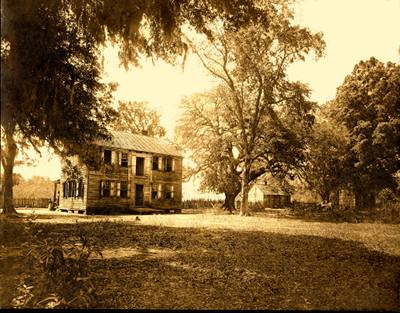Lark Hill Plantation – Oatland – Georgetown County
Basic Information
- Location – Oatland, nine miles up the Black River from Georgetown, Georgetown County
Off Browns Ferry Road / South Carolina Highway 51
- Origin of name – May have been named for meadowlarks or other area songbirds (2, p. 505)
- Other names – ?
- Current status – Privately owned (2001) (2, p. 505)
Timeline
- 1735 – Earliest known date of existence (2, p. 505)
Anthony Atkinson formed the plantation when he received a grant for 500 acres and in the same year purchased an adjoining 600 acres (2, p. 505).
- ? – House built
- Prior to 1747 – Anthony Atkinson acquired an additional grant for 300 acres (2, p. 505).
- 1747 – Anthony Atkinson sold the 1,400 acre plantation to John Pyatt (2, p. 505).
- 1754 – John Pyatt sold the property to James Mitchell (2, p. 505).
- 1764 – Henry Bossard purchased the plantation from James Mitchell (2, p. 505).
- 1769 – Henry Bossard sold 600 acres of the plantation to Henry Futhy (2, p. 505).
NOTE: At this time, the plantation wasn't associated with a formal name. The plantation known as Lark Hill is associated with the Futhy section so that is the property the remainder of this timeline traces.
Henry Futhy acquired adjoining property along the river. Records of Henry Futhy's family are not known to exist. Records do show that the property remained in the Futhy family but the exact relationship and subsequent owners is a bit ambiguous for a period of time (2, pp. 505-506).
- 1805 – Eliza Futhy's marriage contract with George Washington Heriot noted she was entitled to one-third of an 1,127 acre plantation with her mother, Jane Futhy, and brother, Dr. John Futhy, entitled the other two portions. This division appears to be from the estate of John Futhy, assumed to the father and husband (2, p. 506).
- 1808 – The property was advertised for sale under the name Lark Hill Plantation and included two large houses, several outbuildings and slave dwellings. The sale of the plantation appears to have been due to obligations of John Futhy's estate. George Washington Heriot purchased the plantation and he and wife Eliza made Lark Hill their home for the next 40 years (2, pp. 506-507).
- 1831 – The Heriots struggled financially. George Heriot portioned off a section of Lark Hill to satisfy two judgements levied again him. This portioned section was given to Richard O. Anderson and Benjamin Daniel Heirot (relation unknown) jointly (2, pp. 506-507).
- Circa 1848 – George Washington Heriot passed away and Lark Hill Plantation was advertised for sale. George's son, Dr. Henry Futhy Heriot, became the next owner of Lark Hill but it is unclear if he purchased the plantation from his father's estate or inherited it (2, p. 507).
- 1890 – Dr. Henry Futhy Heriot died. His wife Georgiana P. Heriot along with daughters Henrietta P. Anderson and Eliza H. Walker ended up in court as two different wills from Dr. Heriot had been submitted for probate. The more recent, 1886, will was deemed the legal one and widow Georgiana became sole owner of Lark Hill via a trust (2, p. 508).
- 1899 – Lark Hill Plantation passed jointly to sisters, Henrietta P. Anderson and Eliza H. Walker, upon the death of their mother Georgiana P. Heriot (2, p. 508).
- 1901 – Henrietta P. Anderson passed away just two years after her mother and left her share of the plantation to daughters Henrietta P. Hunt, Georgie C. Baldwin, and Corrine W. Anderson (2, p. 508).
- 1902 – The three sisters sold their half of the plantation to their cousins, Marie Walker Holmes and Elise Hasford Walker, the daughters of Eliza H. Walker. Eliza had previously given her share of Lark Hill Plantation to her daughters so the plantation was once again one piece and owned jointly by the Walker sisters (2, p. 508).
- 1929 – Marie Walker Holmes and Elise Hasford Walker sold the 738 acre plantation for $6,000 to Edwin G. Seibels (2, p. 508) (3).
- 1948 – Edwin G. Seibels gave the plantation to his son Calder W. Seibels. The Seibels leased the timber rights to various corporations (2, p. 508).
- 1958 – Calder W. Seibels died and it appears that his widow, Mary Page Seibels (died 1989), or son, John Page Seibels, inherited the plantation.
- 2001 – John Page Seibels, owned Lark Hill Plantation but made his home in Columbia, SC (2, p. 508).
Land
- Number of acres – 1,100 in 1735; 1,400 in 1747; 600 in 1769; 1,127 in 1805; 738 in 1929
- Primary crop – Rice
Slaves
- Number of slaves – ?
References & Resources
- George C. Rogers, Jr., The History of Georgetown County, South Carolina
(Spartanburg, SC: Reprint Company, 1990)
 Order The History of Georgetown County, South Carolina
Order The History of Georgetown County, South Carolina - Suzanne Cameron Linder and Marta Leslie Thacker, Historical Atlas of the Rice Plantations of Georgetown County and the Santee River
(Columbia, SC: South Carolina Department of Archives and History, 2001) pp. 505-508
 Order Historical Atlas of the Rice Plantations of Georgetown County and the Santee River
Order Historical Atlas of the Rice Plantations of Georgetown County and the Santee River - Information contributed by George Holmes, the grandson of owner Marie Walker Holmes.
- Photos held in the Georgetown County Museum Collection:
– Circa 1935 – 21 pictures from Lark Hill Plantation



